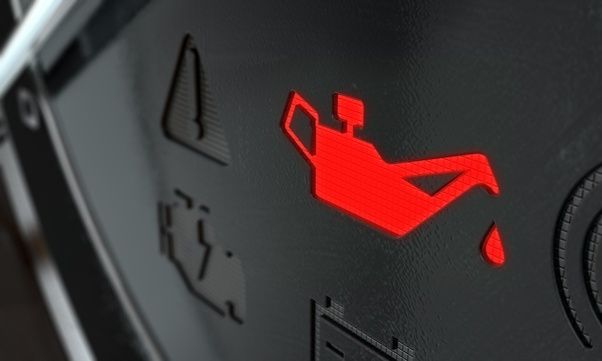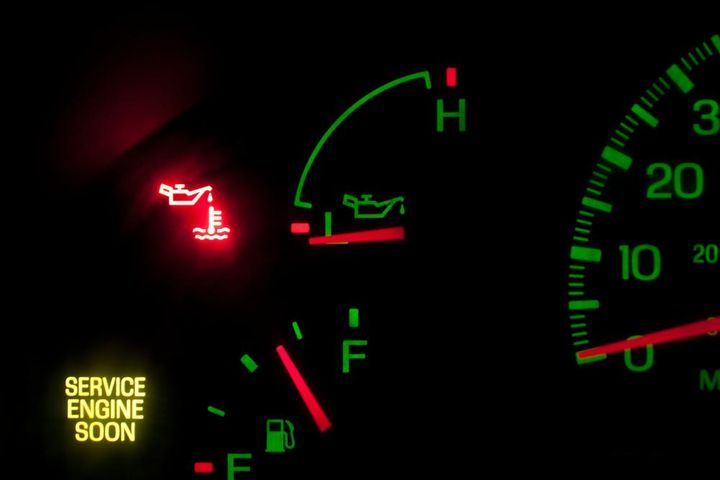


The oil light is an important indicator on a vehicle's dashboard that alerts the driver about potential issues with the engine's lubrication system. It is designed to illuminate when the oil pressure drops below a certain level, which can be caused by various factors. However, in some cases, the oil light may come on and off intermittently, even when the oil level appears to be full. This situation can be perplexing for drivers and may indicate an underlying problem that requires attention.

Before we dive into the nitty-gritty details, let's first understand the purpose of the oil light. This warning indicator is designed to alert you when the engine's oil pressure falls below a certain threshold, which could potentially lead to catastrophic engine damage if left unaddressed. However, the oil light's behavior can sometimes be misleading, as it may not always accurately reflect the actual oil level or condition.
Now, let's explore the various reasons why the oil light might be flickering on and off, even when the oil level appears to be adequate.
| Cause | Description |
|---|---|
| Faulty Oil Pressure Sensor/Switch | The oil pressure sensor or switch is responsible for monitoring the engine's oil pressure and sending a signal to the dashboard light. If this component malfunctions, it can provide false readings, causing the light to turn on and off erratically, regardless of the actual oil level or pressure. |
| Clogged or Dirty Oil Filter | A clogged or excessively dirty oil filter can restrict the flow of oil, leading to reduced oil pressure. This reduction in pressure can trigger the warning light, even if the oil level itself is sufficient. Over time, dirty oil can also contribute to premature clogging of the filter. |
| Low Oil Pressure Due to Worn Engine Bearings/Components | As an engine ages and its components wear down, excessive clearances can develop within the bearings and other critical parts. These clearances can result in low oil pressure, especially at low RPMs when the oil pump rotates more slowly. This low pressure can intermittently activate the oil light, even with a full oil level. |
| Malfunctioning Oil Pump | The oil pump is the heart of the engine's lubrication system, responsible for circulating oil throughout the engine. If the oil pump fails or becomes defective, it may not be able to maintain proper oil pressure, causing the warning light to illuminate. |
| Wrong Oil Viscosity | Using an oil with the incorrect viscosity (thickness) for the operating temperature can affect the oil's flow and pressure characteristics. If the oil is too thick or too thin for the given conditions, it can lead to fluctuations in oil pressure, triggering the warning light intermittently. |
Each of these causes can contribute to the erratic behavior of the oil light, and it's essential to identify the root cause to address the issue effectively.
To accurately diagnose the root cause of the flickering oil light, a thorough inspection is necessary. Here are the steps I typically follow:
Check the Oil Level and Condition
Ensure the oil level is within the recommended range and not contaminated.
Inspect the oil's color and smell for any signs of contamination or degradation.
Inspect for Oil Leaks
Visually inspect for any visible oil leaks that could be contributing to low oil levels or pressure.
Check for leaks around gaskets, seals, and other potential leak points.
Listen for Unusual Engine Noises
Pay attention to any unusual noises, such as knocking or whining, which could indicate worn bearings or a failing oil pump.
Check Oil Pressure with a Mechanical Gauge
Use a mechanical oil pressure gauge to verify if the pressure is within the manufacturer's specifications.
Check the pressure at different RPM ranges to identify any fluctuations or patterns.
Inspect the Oil Filter
Remove and inspect the oil filter for clogs or damage that could be restricting oil flow.
Check for excessive debris or contaminants in the filter.
Evaluate the Oil Pump Operation
Assess the operation of the oil pump to ensure it's functioning correctly.
Listen for any unusual noises or signs of wear or failure.
Depending on the specific issue, you may notice certain telltale signs:
A faulty sensor might cause the light to come on randomly, even with good oil level and pressure.
A clogged filter could result in low pressure at high RPMs and dirty oil.
Worn bearings might manifest as low pressure at idle and knocking noises.
A bad oil pump could lead to low pressure at all RPMs and a whining sound.
Using the wrong oil viscosity could cause pressure fluctuations with temperature changes.
Once the root cause has been identified, it's time to address the issue. Here are the typical repair instructions for each potential cause:
| Cause | Repair Instructions |
|---|---|
| Faulty Oil Pressure Sensor/Switch | Replace the oil pressure sensor or switch with a new, high-quality component. |
| Clogged or Dirty Oil Filter | Replace the oil filter and change the engine oil to ensure fresh, clean lubrication. |
| Worn Engine Bearings/Components | Depending on the severity of the wear, individual bearings or components may need to be replaced, or in extreme cases, a complete engine overhaul might be necessary. |
| Malfunctioning Oil Pump | Replace the oil pump with a new, high-quality unit, following the manufacturer's recommended procedures for proper priming and installation. |
| Wrong Oil Viscosity | Drain the existing oil and refill the engine with the correct viscosity recommended by the manufacturer for your vehicle and operating conditions. |
Throughout the repair process, it's essential to follow the manufacturer's recommended procedures and use high-quality replacement parts. Additionally, ensure that all oil passages are clear of debris and that the new components are properly installed and primed (in the case of the oil pump) to ensure optimal lubrication and pressure.
While addressing the immediate issue is crucial, it's equally important to take preventive measures to avoid future occurrences of the flickering oil light. Here are some tips to help you maintain a healthy engine and prevent oil-related problems:

Follow the recommended oil change intervals and use the correct oil type and viscosity specified by the manufacturer for your vehicle and operating conditions.
Replace the oil filter at every oil change to ensure optimal oil flow and prevent premature clogging.
Regularly inspect for oil leaks and address them promptly to maintain proper oil levels and pressure.
Avoid excessive idling or high RPM operation when the engine is cold, as this can contribute to increased wear and tear on engine components.
Consider using higher-quality synthetic oils, which often provide better protection and longer service intervals compared to conventional oils.
Perform regular maintenance checks and address any issues promptly to prevent further damage or complications.
By following these preventive measures, you can help extend the life of your engine and minimize the likelihood of encountering oil-related issues in the future.
The cost of repairs related to the flickering oil light can vary significantly depending on the specific issue and the labor rates in your area. Here's a table outlining approximate cost ranges for common repairs:
| Repair | Approximate Cost Range |
|---|---|
| Oil Pressure Sensor Replacement | $50 - $200 |
| Oil Filter Replacement | $10 - $30 |
| Oil Pump Replacement (including labor) | $300 - $1000 |
| Engine Bearing Replacement (including labor) | $1000 - $4000 |
It's important to note that preventive maintenance, such as regular oil changes and filter replacements, can help avoid more expensive repairs down the line. By addressing issues promptly and following recommended maintenance schedules, you can potentially save thousands of dollars in costly engine repairs or replacements.
The flickering oil light can be a perplexing and concerning issue for car owners, but with the right knowledge and approach, it can be effectively diagnosed and resolved. By understanding the potential causes, conducting thorough inspections, and following proper repair procedures, you can ensure the longevity and optimal performance of your engine.
Remember, preventive maintenance is key to avoiding oil-related issues and minimizing the risk of costly repairs. By staying vigilant, addressing problems promptly, and following the manufacturer's recommendations, you can keep your vehicle running smoothly and enjoy a worry-free driving experience.
Happy motoring, and may your oil light remain steadily off!
The oil light alerts you when the engine's oil pressure falls below a certain threshold, which could potentially lead to engine damage if left unaddressed.
Yes, a clogged or excessively dirty oil filter can restrict oil flow, leading to reduced oil pressure and triggering the warning light intermittently.
Excessive clearances in worn bearings can result in low oil pressure, especially at low RPMs, causing the oil light to turn on and off erratically.
A malfunctioning or failing oil pump may not be able to maintain proper oil pressure, causing the warning light to illuminate.
Yes, using an oil with an incorrect viscosity for the operating temperature can affect oil flow and pressure, triggering the warning light intermittently.
Thoroughly inspect the oil level, condition, leaks, engine noises, oil pressure with a mechanical gauge, oil filter, and oil pump operation.
Replace the oil pressure sensor or switch with a new, high-quality component.
Follow recommended oil change intervals, use the correct oil type and viscosity, replace the oil filter regularly, and perform regular maintenance checks.
The approximate cost range for an oil pump replacement, including labor, is typically between $300 and $1000.
Preventive maintenance, such as regular oil changes and filter replacements, can help avoid more expensive repairs down the line and extend the engine's life.

Sarah isn't your average gearhead. With a double major in Mechanical Engineering and Automotive Technology, she dived straight into the world of car repair. After 15 years of turning wrenches at dealerships and independent shops, Sarah joined MICDOT to share her expertise and passion for making cars run like new. Her in-depth knowledge and knack for explaining complex issues in simple terms make her a valuable asset to our team.













